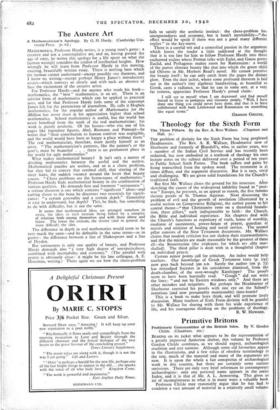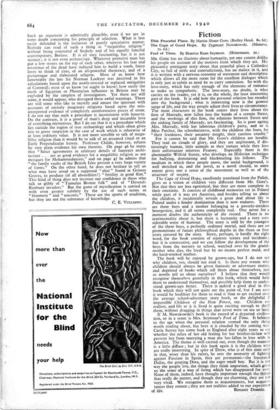Primitive Britons BEARING on its jacket what appears to be
the representation of a greatly improved Anderson shelter, this volume by Professor Gordon Childe combines, as we should expect, archaeological erudition and airy surmise. Although some old favourites appear in the illustrations, and a few relics of obsolete terminology in the text, much of the material and many of the arguments are new. It is upon the whole a fair conspectus of archaeological work in this country, but there are certainly some curious omissions. There are only very brief references to contemporary archaeologists: only one personal name appears in 'the entire Index, and it is that of Mr. A. L. Armstrong. This gives an air of incompleteness to what is in many ways a valuable book.
Professor Childe may reasonably argue that he has had to condense a vast amount of material in a relatively small volume. Such an argument is admittedly plausible, even if we are in some doubt concerning his principle of selection. What is less easily defended is the inclusion of purely speculative matter. Nobody can read of such a thing as " megalithic religion " without being reminded of Stukely and of his equally fanciful contemporary, Borlase. It is all very fascinating, but it is not science ; it is not even archaeology. Wherever primitive man has put a few stones on the top of each other, wherever his fear and reverence of the dead have induced him to build a tomb, fancy loves to think of rites, of an all-powerful theocracy, and of a picturesque and elaborated religion. Most of us know how lamentably the late Sir Norman Lockyer was deceived in his calculations based upon the newly-erected or replaced antiquities of Cornwall; most of us know (or ought to know) how easily the myth of Egyptian or Phoenician influence in Britain may be exploded by the simplest of investigators. Yet there are still some, it would appear, who disregard these awful warnings. There are still some who like to mystify and amuse the ignorant with accounts of entirely imaginary religions based upon the mis- interpreted evidence of completely uninformative pieces of stone. I do not say that such a procedure is inconsistent with honesty. On the contrary, it is a proof of man's deep and incurable love of everything mysterious. But I do say that it is a procedure which lies outside the region of true archaeology and which often gives rise to grave suspicion in the case of work which is otherwise of at least ordinary value. It is not more sensible to talk of mega- lithic religion than it would be to talk of an arcuated ritual or an Early Perpendicular heresy. Professor Childe, however, refutes by very plain evidence his own theories. On page 46 he states that " Strict agreements in arbitrary details of funerary archi- tecture . . . are as good evidence for a megalithic religion as are mosques for Mohammedanism," and on page 47 he admits that " the family vaults of the British Isles present a very large variety of forms." On the other hand, he does not hesitate to tell us what may have stood on a supposed " altar " found at Grimes Graves, to produce (of all absurdities!) " fertility in good flint." This kind of thing does not increase our confidence in those who talk so glibly of " Tumulus Bronze folk " and of " Deverel- Rimbury invaders." But the game of mystification is carried on with even greater subtlety by the use of such terms as " bloomery " and " aniconic." These are the sports of erudition, but they are not the substance of knowledge. C. E. VULLIAMY.



























 Previous page
Previous page